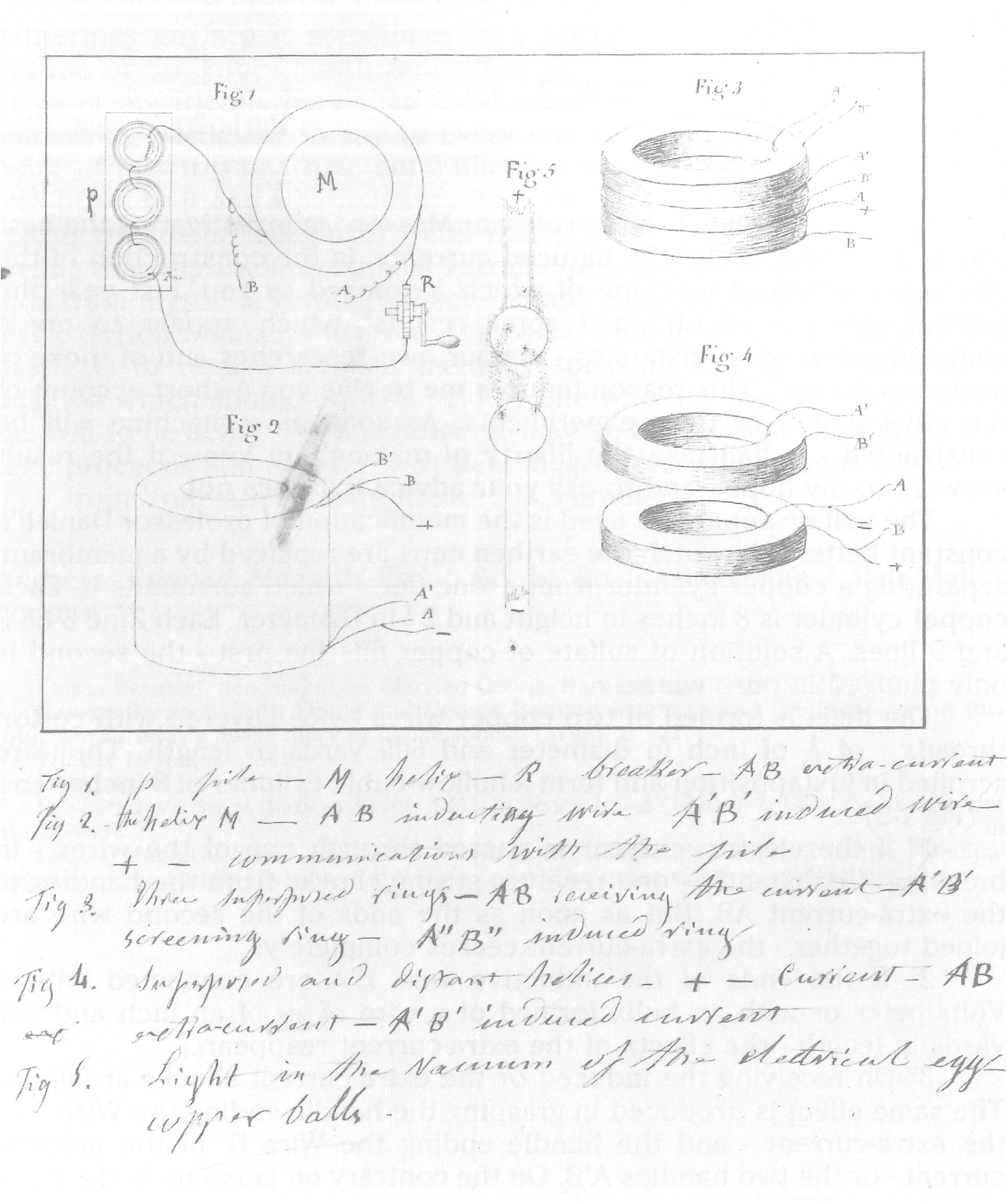Peyron to Faraday 20 August 18411
Paris 20 August 1841
To Doctor Faraday F.R.S.
Sir
My friends Breguet2 and professor Masson3 in investigating the best way of rendering useful the induced currents, in the construction of the electrico-magnetical machine of which I exposed to you, last year the general plan4, have obtained some results5 which appear to me a complement in some instances - of your own researches and of those of professor Henry6. This reason induces me to give you a short account of the chief points of their experiments. As soon as a machine will be constructed - I shall take the liberty of making you know if the result answers to my hope - and to ask your advice if it does not.
The voltaic apparatus used is the modification of professor Daniell's constant battery7 in which the earthen cups are replaced by a membrane separating a copper cylinder from a zinc one - which surrounds it. Each copper cylinder is 8 inches in height and 2 1/2 in Diameter. Each Zinc 8 on 3 and 9 lines. A solution of sulfate of copper fills the first - the second is only plunged in pure water.
The helix is formed of two copper wires twice covered with cotton threads - of 1/10 of inch in diameter and 605 yards in length. They are scrolled in juxtaposition and form a hollow cubic cylinder of 8 inches and 9/10 (Fig 1-2)

1˚ if the electric current is passed through one of the wires - in breaking it constantly - one receives strong shocks from the handles of the extra-current AB. But as soon as the ends of the second wire are joined together - the extra-current ceases completely.
2˚ If the ends of the inductive wire B'A are connected with a Voltameter or with an helix formed of a wire of 1/300 of an inch and 500 yards in length - the effects of the extra-current reappear[.]
3˚ On receiving the induced or the extra-current shocks are given. The same effect is produced in grasping the handle ending the Wire A of the extra-current - and the handle ending the Wire B' of the induced current - or the two handles A'B. On the contrary on grasping in the same time AA' or BB' nothing at all is felt[.]
The handles AB' being kept by one person - as soon as the two handles A'B shall be connected - or shall be touched by another person - the shocks become stronger. The same result takes place with two helices of various lengths superposed and distant of 7/10 of an inch (Fig 4)[.]
4˚ Three helices being superposed as it is shewn in the Fig 3 - the first formed of 38 yards of copper wire 1/10 of an inch in diameter - the second of 176 yards of copper wire 1/300 of an inch and the third of 230 yards of the same fine wire - constituting rings of 6 inches in diameter - if broken currents from ten elements pass through the first - the two ends of the second being united - the third is not induced. But as soon as the ending wires of the second ring are connected with a voltameter - or with the helix above described the induction appears and shocks are received.
5˚ The two wires in the helix fig 2. being united so as to form a single one of 1210 yards - if the wires of the extra-current are connected with the conductors of the electrical egg - between the terminal - gold - silver - platina - copper - zinc - iron - charcoal balls - shall appear all the series of phenomena obtained with a powerful electrical machine. The positive ball is always surrounded by a constant violet glow rising some inches along the rod which supports it. From the obscure negative balls - flows a red brush reaching the positive. In using copper balls - red squibs rush out from the negative - ending in brilliant and white stars surrounded by a green glow - connecting the basis of the brush with every point of the surface of the positive ball and rod (Fig. 5). In using platina - if instead of the positive ball - an helix with loose curls - is applied to the rod - the violet glow is more extended and intense. In every case the brush takes place at a distance and without any previous contact[.]
6˚ During the preceding experiments an iron cylinder 50 pounds weight being introduced into the hollow of the helix - the shocks grow suddenly weaker - the light diminishes and sometimes vanishes.
I desire that communication to be agreeable to you. There are some new facts not yet cleared up which I shall [word illegible] to you after renewed experiments[.]
I am Sir | Your most grateful and obedient | servant | Peyron
I have undertaken the translation of your Experimental Researches, the very Code of electricians of which I ambition to endow my own country. I hope that long and difficult task will be completed next year. But before publishing it I shall have the pleasure of submitting my attempt to your approbation[.]
Endorsed by Faraday: Dr. Peyron professor of natural philosophy, Marseilles 18 Rue d'Aguesseau, Paris.
Bibliography
HENRY, Joseph (1839): “Contributions to Electricity and Magnetism. No. III.- On Electro-Dynamic Induction”, Trans. Am. Phil. Soc., 6: 303-37.
Please cite as “Faraday1361,” in Ɛpsilon: The Michael Faraday Collection accessed on 30 April 2024, https://epsilon.ac.uk/view/faraday/letters/Faraday1361